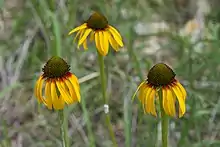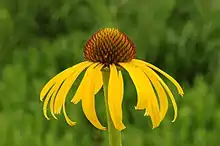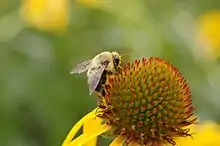| Echinacea paradoxa | |
|---|---|
 | |
| Scientific classification | |
| Kingdom: | Plantae |
| Clade: | Tracheophytes |
| Clade: | Angiosperms |
| Clade: | Eudicots |
| Clade: | Asterids |
| Order: | Asterales |
| Family: | Asteraceae |
| Genus: | Echinacea |
| Species: | E. paradoxa |
| Binomial name | |
| Echinacea paradoxa (J. B. S. Norton) Britt. | |
| Synonyms[1] | |
| |
Echinacea paradoxa, the yellow coneflower,[2] Bush's purple coneflower,[3] or Ozark coneflower,[4] is a North American species of flowering plant in the family Asteraceae. It is native to southern Missouri, Arkansas, and south-central Oklahoma, It is listed as threatened in Arkansas.[3][5]
Description
Echinacea paradoxa is a perennial herb up to 90 cm (3 ft) tall with multiple, slightly hairy stems arising from the rootstock. Most of the leaves are basal leaves with smooth margins. They are alternate, becoming shorter higher up on the stem, and they are completely absent on the upper two-thirds of the stem. The basal leaves are 8–45 cm (3–18 in) long and narrowly elliptic to lanceolate, and the stem leaves are 4–35 cm (2–14 in) long and linear to narrowly elliptic or narrowly lanceolate.[6]
One plant can produce several flower heads, each with white, pink, or yellow ray florets surrounding a central head of numerous disk florets.[5][7][8][9] Each flower head is about 5–6 cm (2–2.5 in) across. The central head is dome-shaped and dark reddish brown to nearly black. It is prickly to the touch.[4] It blooms in May and June.[6]
Taxonomy
- Echinacea paradoxa var. paradoxa - yellow rays - Arkansas and Missouri - yellow coneflower or Ozark coneflower[4]
- Echinacea paradoxa var.neglecta - pink or white rays Oklahoma and Texas - Bush's purple coneflower[4]
Echinacea paradoxa var. paradoxa has a baseline chromosome number of x = 11, like most Echinacea plants.[10]
Distribution and habitat
Echinacea paradoxa var. paradoxa, or yellow coneflower, is endemic to the Ozarks of Missouri and Arkansas. It is listed as imperiled in Arkansas.[11]
Echinacea paradoxa var. neglecta, or Bush's purple coneflower, is currently only known to exist in the wild in the Arbuckle Mountains region of southeastern Oklahoma. One isolated population was reported from Montgomery County in eastern Texas. It is listed as critically imperiled in Oklahoma and presumed extirpated in Texas.[12]
Habitats include partially sunny to sunny savannas, glades, limestone outcroppings, barrens, open hillsides, and bald knobs.
Gallery
 Illustration
Illustration Flower
Flower Flower from above
Flower from above Flower and a bee
Flower and a bee Flower closeup with a bee
Flower closeup with a bee
References
- 1 2 "Echinacea paradoxa Britton". www.worldfloraonline.org.
- ↑ "Echinacea paradoxa - Plant Finder". www.missouribotanicalgarden.org.
- 1 2 Echinacea paradoxa United States Department of Agriculture plants profile
- 1 2 3 4 "Ozark Coneflower (Echinacea paradoxa paradoxa)". www.illinoiswildflowers.info.
- 1 2 3 Flora of North America, Echinacea paradoxa (Norton) Britton
- 1 2 "Echinacea paradoxa page". www.missouriplants.com.
- ↑ Britton, Nathaniel Lord & Brown, Addison 1913. illustrated flora of the northern United States, Canada and the British possessions : from Newfoundland to the parallel of the southern boundary of Virginia, and from the Atlantic Ocean westward to the 102d meridian 3: 476 description in English plus lline drawing
- ↑ Norton, John Bitting Smith 1902. Transactions of the Academy of Science of St. Louis 12(4): 40–41 description and commentary in English, as Brauneria paradoxa
- ↑ Norton, John Bitting Smith 1902. Transactions of the Academy of Science of St. Louis 12(4): plate VIII (8) line drawing of Echinacea paradoxa as Brauneria paradoxa
- ↑ Smith, E. B., P. E. Hyatt, and K. Golden. 1992. Documented chromosome numbers 1992: 1. Chromosome numbers of some Arkansas flowering plants. Sida 15:145–146.
- ↑ "NatureServe Explorer 2.0". explorer.natureserve.org.
- ↑ "NatureServe Explorer 2.0". explorer.natureserve.org.
 Media related to Echinacea paradoxa at Wikimedia Commons
Media related to Echinacea paradoxa at Wikimedia Commons Data related to Echinacea paradoxa at Wikispecies
Data related to Echinacea paradoxa at Wikispecies
